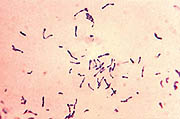Symptoms and Causes of Diphtheria

Corynebacterium diphtheriae culture
|
Diphtheria is a bacterial infection that spreads easily and occurs quickly. It mainly affects the nose and throat. Children under 5 and adults over 60 years old are particularly at risk for contracting the infection. People living in crowded or unclean conditions, those who aren't well nourished, and children and adults who don't have up-to-date immunizations are also at risk.
Diphtheria is rare in the United States and Europe, where health officials have been immunizing children against it for decades. However, it's still common in developing countries where immunizations aren't given routinely. In 1993 and 1994, more than 50,000 cases were reported during a serious outbreak of diphtheria in countries of the former Soviet Union.
SYMPTOMS:
It begins with sore throat and fever. Frequently a dirty, white of grayish membrane forms in the throat or nose, or both. There are slight chills, possible vomiting and diarrhea, always fetid breath, difficulty in swallowing, and hoarseness.
Children first complain of feeling tired and sleepy. The tonsils appear inflamed, dark red, and unevenly swollen. White parchment-like patches appear on them. The glands in the neck usually swell. If there are no white patches or developing membrane, it is not diphtheria.
CAUSES:
Diphtheria is caused by bacteria called Corynebacterium diphtheriae or C. diphtheriae. The bacteria spread when an infected person coughs or sneezes and droplets of their saliva enter another personís mouth or nose.
Less commonly, diphtheria can be spread on household items, such as glasses, towels or utensils that have been contaminated by an infected person.
Once a person is infected, the bacteria quickly multiply and spread through the inside surface of the mouth, throat and nose.
In the most serious cases of diphtheria, the bacteria produce a toxin. The toxin begins killing cells in the throat. The dead cells rapidly build up and form the gray-white membrane (or covering) in the throat. The toxin can also spread through the blood and damage the heart and nervous system.
|